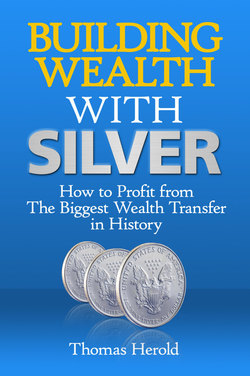Читать книгу Building Wealth with Silver - Thomas Herold - Страница 22
На сайте Литреса книга снята с продажи.
Fractured Finance – Fractional Reserve Banking
ОглавлениеThis creating money by monetizing the government’s debt is not the only way that the Fed is able to create new dollars. They can also use the Fractional Reserve Banking System that underpins the modern banking of practically all countries in the world.
Fractional reserve banking significantly expands the money supply, or demand deposits and cash, beyond the level at which it would normally be.
Because of how common the practice of fractional reserve banking proves to be, the actual money supply found in the majority of nations is a multiple bigger than only the base level of money that a nation’s Central Bank creates.
The multiple itself is known as the money multiplier. This number is set by the minimum reserve requirement that the financial regulatory authorities require and impose on banks. Extra reserves that banks hold also influence the level of this multiple.
You will find that most central banks, including the Federal Reserve, generally set these minimum reserve requirements for the banks. This ensures that banks maintain at least a minimal amount of their on demand deposits in cash reserves. In such a way, the money creation performed in the commercial banking realm is controlled by the Central Bank or Federal Reserve.
This is also intended to make certain that banks possess sufficient available on hand cash to deal with typical withdrawal demands. Even though these fractional reserve minimums are intended to prevent them, difficulties can become evident if a great number of bank depositors attempt to pull out their money at once. This leads to bank runs on rare occasions. If the problems are exaggerated to banks throughout a region or are severe, it can also cause a systemic crisis in the banking system.
To help alleviate these types of difficulties and protect the system, the Federal Reserve oversees and closely regulates such commercial banks. It furthermore functions as a true lender of last resort for them. Besides this, another body, the FDIC, or Federal Deposit Insurance Corporation, insures commercial bank customers’ deposits.
Because banks are allowed to lend out a certain multiple of the deposits that they actually have, they can be utilized by the Federal Reserve to create additional money. You have already seen that they can lend out a multiple of the deposits that they have on hand. Another way of putting this is that the Federal Reserve only requires them to keep a certain percentage of loans that they make as reserves.
Typically, this fractional reserve number is ten percent. This means that for every $1 that they have in reserves, a bank is allowed to loan out $10. They are given a money multiplier of ten to one with this reserve.
So when the Fed purchases Treasuries by crediting a financial institution’s account, they are electronically increasing the reserves’ value of the bank in question. The bank is then not simply able to loan out these deposits that are magically credited to them digitally, but instead the full fractional reserve multiplier of what is typically ten to one.
This means that the Federal Reserve creates not only the money that they use to purchase treasuries with, but also the ten to one in new money that is created by a bank loaning out up to their fractional reserve requirements.
Every modern bank in the United States operates on this system of fractional reserve lending. This whole explanation may come as a shock to you, as it does to most Americans when they learn of it. Reality is that far more money is loaned out than the banks literally keep in reserves. Although there are restrictions to how much money the banks can create, you have already seen that the restrictions are mostly limited to the ten percent fractional reserve requirement.
Should the Federal Reserve Bank desire it, they can lower the reserve still further, allowing yet more money to be created as if by magic from thin air. This has profound implications for your money and its value. Later in the chapter we will examine what this means for you and your paper and electronic dollars.
